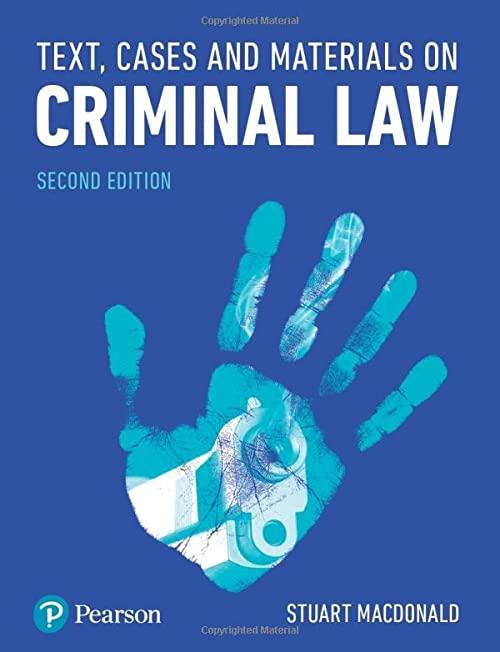Question
Illinois v. Wardlow, 2000 On September 9, 1995, police officers Nolan and Harvey were working in the special operations section of the Chicago Police Department.
Illinois v. Wardlow, 2000
On September 9, 1995, police officers Nolan and Harvey were working in the special operations section of the Chicago Police Department. Driving in a four-car caravan, they converged on an area known for heavy narcotics trafficking. As their car passed 4035 West Van Buren, Nolan observed a man holding an opaque bag standing next to the building. The officers
turned their car southbound and watched the man as he ran through the gangway and an
alley. The officers stayed in their vehicle but pursued the man. When they cornered him on the
street, Nolan exited his car and stopped the suspicious person. The officer conducted a patdown
search for weapons because it was common to find weapons in the area where narcotics
transactions occurred.
During the frisk, Officer Nolan squeezed the bag and felt an object similar to the shape of a gun. He proceeded to open the bag and discovered a .38-caliber handgun with five live rounds
of ammunition. The officer arrested Wardlow.
Wardlow's attorney filed a motion to suppress the evidence. The Illinois trial court denied the motion, finding that the gun was recovered during a lawful stop and frisk. Wardlow was convicted of unlawful use of a weapon by a felon. Wardlow appealed the decision, and the State Appellate Court reversed the lower court. The State Appellate Court said that, under Terry v. Ohio, Nolan did not have reasonable suspicion to make the stop. On appeal by Illinois, the state supreme court upheld the ruling, determining that sudden flight in a high crime area does not create a reasonable suspicion justifying a "Terry stop," because flight may simply be an exercise of the right to "go on one's way."
Constitutional Issue
In Terry v. Ohio, the Supreme Court had held that an officer may, consistent with the
Fourth Amendment, conduct a stop and frisk when the officer has a reasonable suspicion
that there is criminal activity going on. In this case, the issue is whether the mere act of
fleeing from the police meets the "reasonable suspicion" requirement for a stop and frisk.
If the stop and frisk meets this standard, the evidence discovered may be admitted in court.
The Supreme Court's Decision
The United States Supreme Court granted certiorari, and Chief Justice Rehnquist delivered the majority opinion. The justices found that the officers' actions did not violate the Fourth Amendment. Rehnquist referred to the case of Terry v. Ohio, under which an officer who has a "reasonable, articulable suspicion that criminal activity is afoot may conduct a brief, investigatory stop." While an individual's presence in a "high crime area" is not enough to support a reasonable suspicion of criminal activity, a location's characteristics are relevant in helping determine whether the circumstances warrant further investigation. In this case, Wardlow's unprovoked flight aroused the officers' suspicions. "Nervous, evasive behavior is another pertinent factor in determining reasonable suspicion, . . . and headlong flight is the consummate act of evasion." Because the courts do not have scientific standards of reasonable suspicion to review an officer's decision, it must be based on commonsense judgments and inferences about human behavior.
The Court said that Officer Nolan was justified in suspecting that Wardlow was involved in criminal activity and, therefore, in investigating further. Any individual, when approached, has
a right to ignore the police and go about his business, but unprovoked flight is the exact opposite
of "going about one's business." "Allowing officers confronted with such flight to stop the
fugitive and investigate further is quite consistent with the individual's right to go about his
business or to stay put and remain silent in the face of police questioning." The Court agreed
that there is a risk that officers may stop innocent people, but Wardlow recognized that officers
can detain individuals to resolve ambiguities in their conduct. In such instances, Wardlow
requires that the officer be able to articulate more than an "inchoate and unparticularized suspicion or 'hunch' of criminal activity." Unprovoked flight is, however, not a mere refusal to
cooperate.
Questions
1. What role did the area where Wardlow was standing play in the way the Court viewed the
chase and stop?
2. Why did the lower courts believe that the stop and frisk were not consistent with the
Fourth Amendment?
3. How would you define "reasonable suspicion"?
4. Should the fact that Wardlow was found to be carrying a weapon have been taken into consideration by any of the courts? Why or why not?
5. How will the decision, in this case, affect future conduct by police officers?
Step by Step Solution
There are 3 Steps involved in it
Step: 1

Get Instant Access to Expert-Tailored Solutions
See step-by-step solutions with expert insights and AI powered tools for academic success
Step: 2

Step: 3

Ace Your Homework with AI
Get the answers you need in no time with our AI-driven, step-by-step assistance
Get Started


